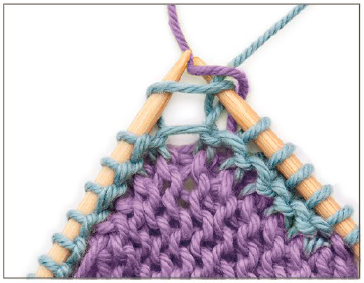 Pin
Pin Knitting is a craft where yarn is turned into fabric or garments using two or more needles that interlock loops of yarn. By creating and manipulating these loops, it is possible to form a wide range of patterns and designs. Knitting can be done with various materials such as wool, cotton, silk, or synthetic fibers to create objects such as hats, scarves, shawls, sweaters, blankets, and much more. The craft of knitting is thought to have originated in the Middle East and spread throughout the world. It has evolved significantly over the centuries, with many variations in techniques, styles, and designs. Knitting is a popular hobby, as well as a means of creating handmade gifts, clothing, and home decor. Additionally, it is also a therapeutic activity known for its calming and relaxing effects on the mind and body.
Single cast-on
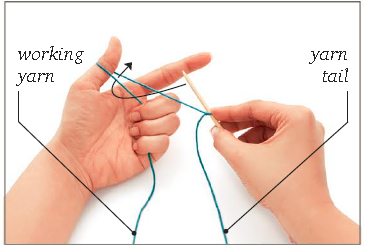 Pin
Pin Step 1: Hold the needle with the slip knot
in your right hand. Place the wool, as shown, around your left thumb and hold it with your other fingers. Then take the needle around the thread in the direction shown by the arrow.
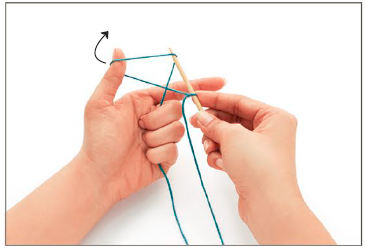 Pin
Pin Step 2: Let the yarn slip off your thumb and pull the yarn to tighten the new cast-on loop on the needle, sliding it up close to the slip knot.
 Pin
Pin Step 3: Loop the yarn around your thumb again and repeat this process until you have as many stitches on the needle as required.
Knit-on cast-on
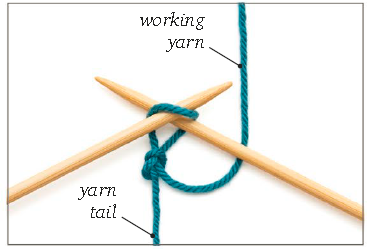 Pin
Pin Step 1: Place the needle with the slip knot on it in the left hand. Insert the tip of the right needle from right to left through the centre of the loop on the left needle, as shown.
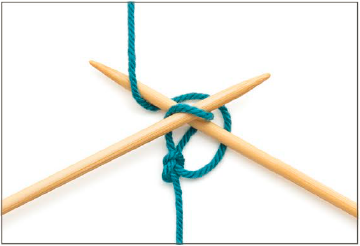 Pin
Pin Step 2: With the yarn behind the needles, wrap it under and around the tip of the right needle. While casting on, use the left forefinger or middle finger to hold the loops on the left needle in position.
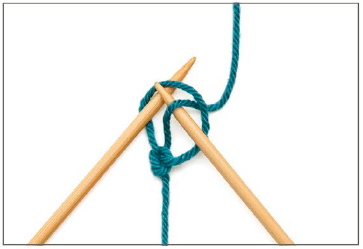 Pin
Pin Step 3: With the tip of the right needle, carefully draw the yarn through the loop on the left needle. This is the same way that knit stitch is formed.
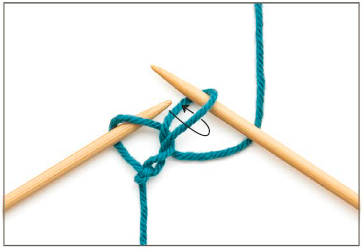 Pin
Pin Step 4: Transfer the loop on the right needle to the left needle by inserting the tip of the left needle from right to left through the front of the loop.
 Pin
Pin Step 5: Pull both yarn ends to tighten the new cast-on loop on the needle, sliding it up close to the slip knot.
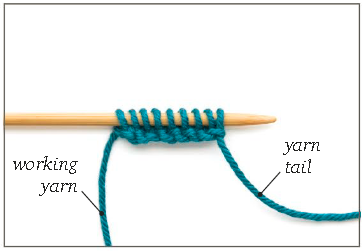 Pin
Pin Step 6: Continue in this way until you have the required number of stitches.
Knit stitch
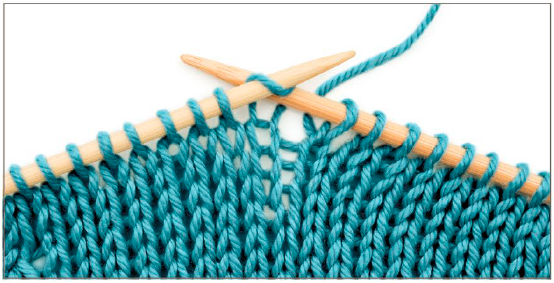 Pin
Pin Step 1: Hold the needle with the unworked stitches in your left hand and the other needle in your right hand. With the working yarn behind the needle, insert the right needle from left to right through the centre of the next stitch to be worked on the left needle
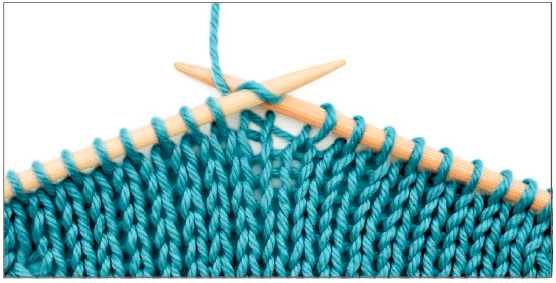 Pin
Pin Step 2: Wrap the yarn under and around the tip of the right needle, keeping an even tension on the yarn as it slips through your fingers.
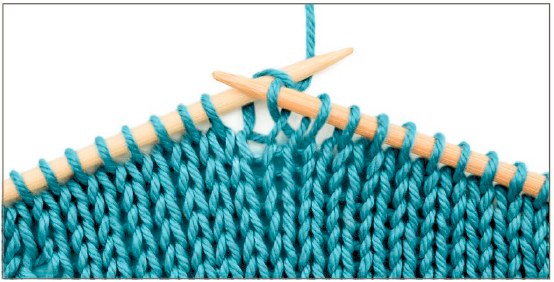 Pin
Pin Step 3: Catch the yarn with the tip of the right needle and carefully draw it through the stitch on the left needle. Try to hold the yarn firmly but not too tightly.
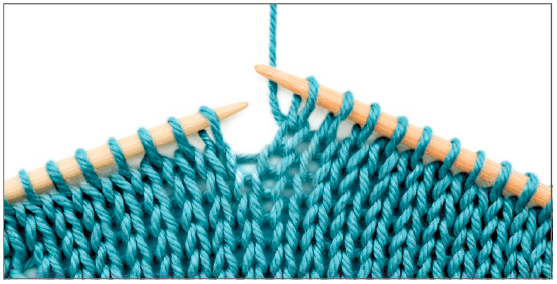 Pin
Pin Step 4: Let the old loop drop off the left needle to complete the stitch. Work all the stitches on the left needle onto the right needle in the same way to complete the row. Turn the work and transfer the right needle to the left hand.
Purl stitch
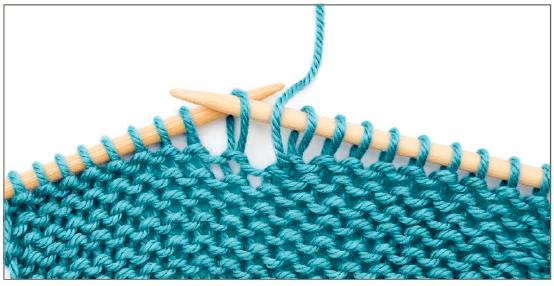 Pin
Pin Step 1: Hold the free working needle in your right hand. With the working yarn at the front of the knitting, insert the tip of the
right needle from right to left through the centre of the next stitch to be worked on the left needle.
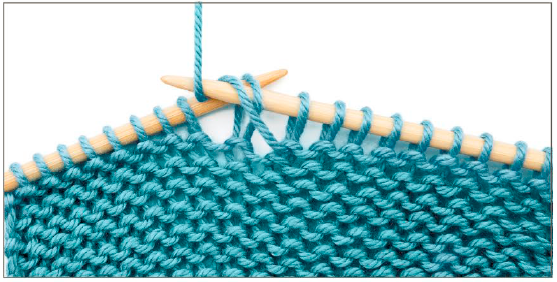 Pin
Pin Step 2: Wrap the yarn over and around the tip of the right needle. Try to keep an even tension on the yarn as you release the yarn through your fingers.
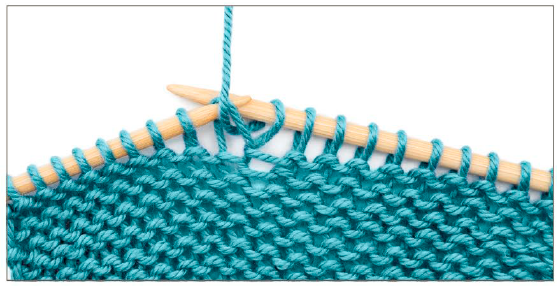 Pin
Pin Step 3: With the tip of the right needle, carefully draw the yarn through the stitch on the left needle. Keep you hands relaxed and allow the yarn to slip through your fingers in a gently controlled manner.
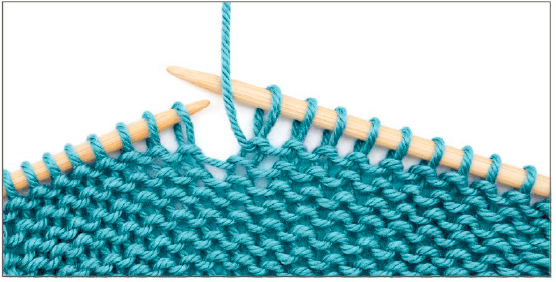 Pin
Pin Step 4: Let the old loop drop off the left needle to complete the stitch. Work all the stitches on the left needle onto the right needle in the same way to complete the row. To start the next row, turn the work and transfer the knitting to the left hand.
Garter stitch
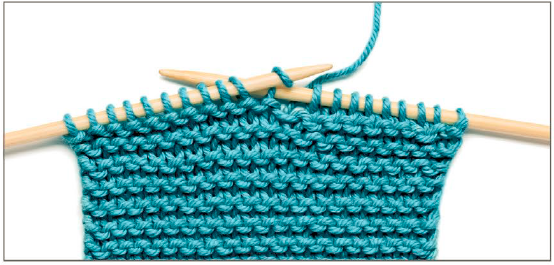 Pin
Pin Step 1: Garter stitch is worked entirely in knit stitch. The right and wrong sides look the same. When the right side of the fabric is facing you, knit all the stitches in the row.
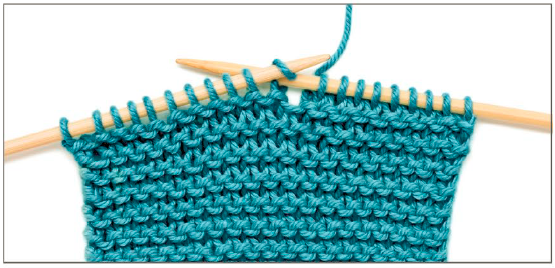 Pin
Pin Step 2: When the wrong side of the fabric is facing you, knit all the stitches in the row. The resulting fabric is soft, textured, and slightly stretchy with edges that lie flat.
Stocking stitch
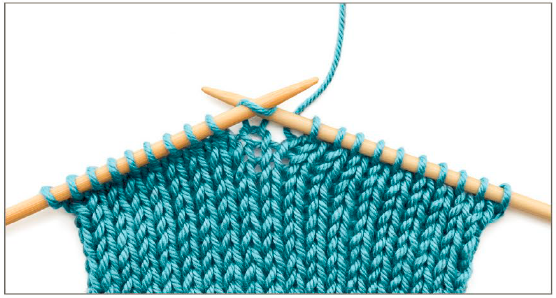 Pin
Pin Step 1: Stocking stitch is formed by working a row of knit stitches and a row of purl stitches alternately. When the right side of the fabric is facing you, as shown, knit all the stitches in the row.
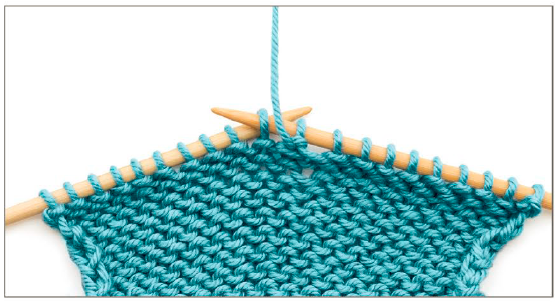 Pin
Pin Step 2: When the wrong side of the fabric is facing you, as shown, purl all the stitches in the row. The wrong side is often referred to as the “purl side” of the knitting.
Tension square
Before beginning any knitting project, you should make a tension square. Depending how loosely or tightly you knit, you may need to use a different needle size in order to achieve the tension required by the pattern.
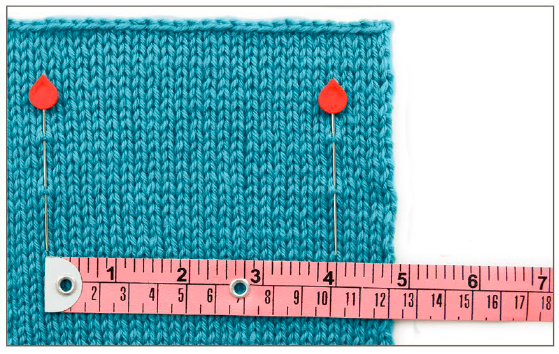 Pin
Pin Step 1: Using the specified needle size, knit a swatch about 13cm (5in) square. Mark 10cm (4in) across the centre of your swatch with pins and count the cumber of stitches between the pins.
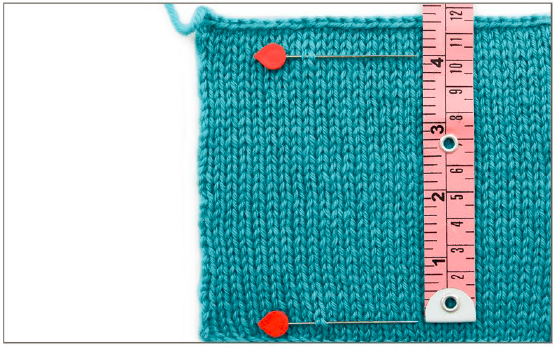 Pin
Pin Step 2: Count the number of rows to 10cm (4in) in the same way. If you have fewer stitches and rows than you should, try again with a smaller needle size; if you have more, change to a larger needle size. Use the needle size for your knitting that best matches the correct tension given for your pattern.
Knit 2 stitches together
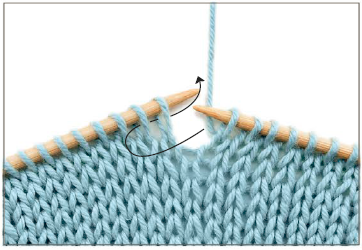 Pin
Pin Step 1: Insert the tip of the right needle from left to right through the second stitch then the first stitch on the left needle.
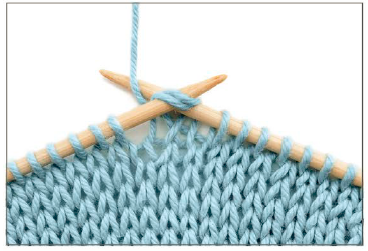 Pin
Pin Step 2: Wrap the yarn around the tip of the right needle, draw the yarn through both loops, and drop the old stitches off the left needle.
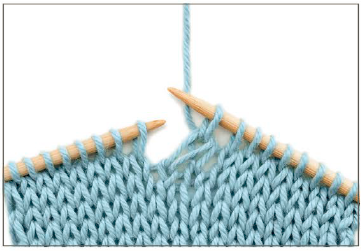 Pin
Pin Step 3: This makes two stitches into one and decreases one stitch in the row. The completed stitch slants right.
Knitting with five double-pointed needles
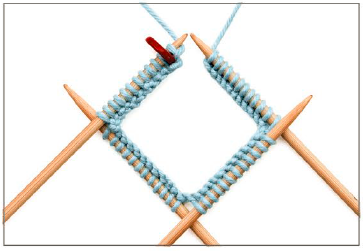 Pin
Pin Step 1: Cast on your stitches on a single needle, then distribute them across 4 double-pointed needles. Insert a stitch marker between the first 2 stitches on the first round. Arrange the needles to form a square, taking care not to twist your cast-on row.
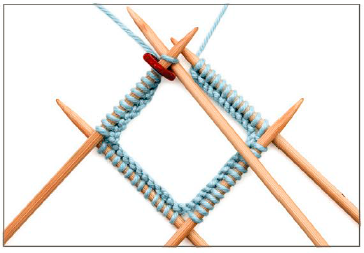 Pin
Pin Step 2: You knit with the free, fifth needle. Knit the first stitch on each needle tightly to avoid gaps at the point where you transition from 1 needle to another.
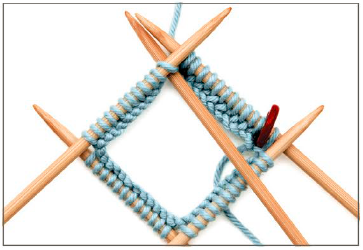 Pin
Pin Step 3: When the stitches on the first needle have all been knitted, this becomes your working needle. Continue to knit in rounds slipping the stitch marker from the left to right needle when it is reached.
Knitting in moss stitch
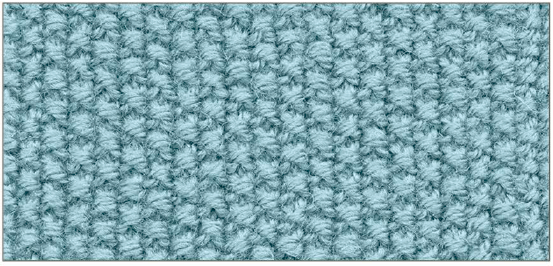 Pin
Pin Cast on an even number of stitches. On the right side, work knit 1, purl 1, alternating; on the wrong side, work purl 1, knit 1, again alternating. If you have an uneven number of stitches, you should simply knit 1, purl 1 on all rows to ensure you always end with a knit stitch.
Knitting with multiple colours
Two-colour garter stitch stripe
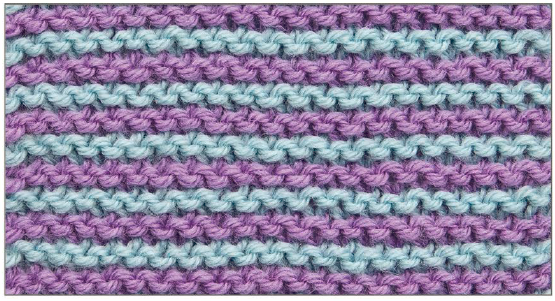 Pin
Pin This narrow stripe pattern is worked in Garter stitch in two colours. To work the stripe, knit 2 rows in each colour alternately, dropping the colour not in use at the side of the work and picking it up again when it is needed.
Tidy edges
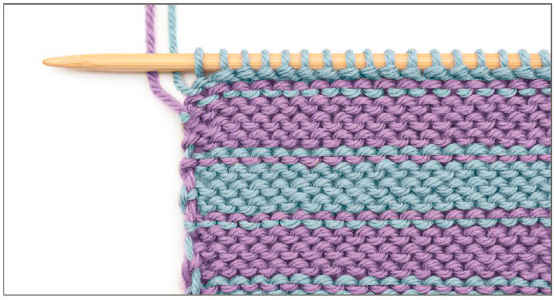 Pin
Pin When working two coloured, even row stripes, twist the yarn around each other every 1–2cm (1⁄2–3⁄4in) up the side of the piece. Alternating the direction of the twist after each colour change prevents the yarns becoming tangled. Be careful not to pull them tightly or the edge will pucker. This technique may make a bulky seam if used with more than two colours.
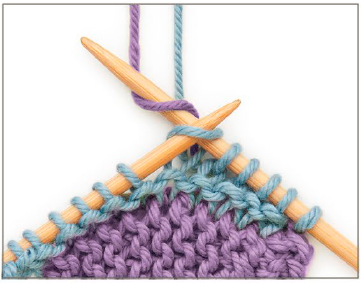 Pin
Pin Step 1: On right side rows it is possible to weave in ends as you knit. Start with the new colour held in the right hand, and the old colour over the left index finger. Insert the right needle into the first stitch, bring the old colour around front of right needle from right to left.
 Pin
Pin Step 2: Bring the new colour between the needles and knit the stitch as normal. By doing this, the old colour yarn slips to the right and over the tip of the right needle, so it is not caught up as part of the new stitch. On the next stitch don’t knit in the old yarn.
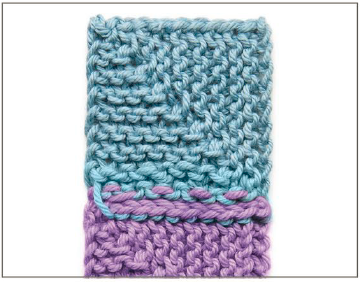 Pin
Pin Step 3: Repeat steps 1 and 2 until the old yarn end has been firmly secured. Knit until finished, then snip the yarn ends. Leave around 1cm (½in) hanging so that the ends don’t slip through to the right side and become visible.
Learning knitting can be a fun and rewarding hobby. While it may seem daunting at first, with the right approach and some practice, anyone can learn to knit in a super easy way. Below are some detailed steps to help you get started:
- 1. Gather the right materials: To begin knitting, you will need a pair of knitting needles and a skein of yarn. It is recommended to start with medium-sized, straight needles as they are easier to handle for beginners. Choose a smooth, medium-weight yarn in a light color, as it will be easier to see your stitches.
- 2. Learn the basic knitting stitches: The two basic stitches in knitting are the knit stitch (k) and the purl stitch (p). The knit stitch creates a smooth, knitted fabric, while the purl stitch creates a bumpy texture. Take a few minutes to watch video tutorials or read step-by-step guides on how to make these stitches. Practice making them slowly and consistently until you feel comfortable.
- 3. Start with a simple project: Begin by choosing a simple knitting project that will allow you to practice your newly acquired skills. A great project for beginners is a dishcloth or a scarf. These projects usually only require knitting in one direction, which makes them ideal for practicing your basic stitches.
- 4. Take it slow and be patient: Knitting is a skill that requires practice, so don’t be discouraged if your first attempts don’t turn out perfectly. Take your time, and remember that mistakes are a part of the learning process. If you make a mistake, simply unravel your work to the mistake and try again. With practice, your stitches will become more even, and your knitting will improve.
- 5. Join a knitting community or class: If you find that you enjoy knitting and want to immerse yourself further in the craft, consider joining a knitting community or taking a knitting class. These communities can provide support, inspiration, and guidance for knitters of all levels. Sharing your progress and learning from others can be a great way to enhance your knitting skills.
- 6. Experiment with different stitches and patterns: Once you feel comfortable with the basic stitches, don’t be afraid to explore different knitting stitches and patterns. There are countless resources available online, in books, or through knitting communities that offer a wide array of knitting patterns and techniques. Trying out new stitches and patterns will keep your knitting exciting and continue to challenge your skills.
- 7. Practice regularly: Like any skill, knitting requires practice and repetition to improve. Set aside regular time each week to practice knitting, even if it’s just for a few minutes. The more you practice, the more comfortable and skilled you will become.
Learning knitting in a super easy way is possible with the right materials, practice, and patience. By starting with the basic stitches, choosing simple projects, and gradually building your skills, you can become a proficient knitter in no time. Enjoy the process and have fun creating beautiful knitted items!
Learning to knit can be a bit challenging at first, but with patience and practice, anyone can overcome common obstacles. Here are some tips to simplify the learning process:
- 1. Start with the basics: Begin with simple projects and techniques. Master the basic stitches, such as the knit stitch and purl stitch, before moving on to more complex patterns. Building a strong foundation is crucial in knitting.
- 2. Use smooth and light yarn: Choose a smooth and light yarn in a light color, as it will help you see your stitches more clearly. Bulky or textured yarn can make it difficult to identify mistakes or manipulate the stitches.
- 3. Use large knitting needles: Start with larger-sized knitting needles, as they are easier to handle and can make your stitches more visible. A size 8 or 9 (US) or 4.0-5.5mm (UK) is recommended for beginners.
- 4. Take it one step at a time: Break down your projects into small manageable parts. Instead of attempting a complex sweater right away, start with small projects like dishcloths or scarves to practice different techniques and stitches.
- 5. Watch online tutorials: There are countless online knitting tutorials available for free. Utilize platforms like YouTube to learn visually and follow step-by-step instructions. Seeing someone knit can often make it easier to understand the process.
- 6. Join a knitting group or take a class: Engage with fellow knitters through in-person or online knitting groups. They can provide guidance, support, and helpful tips. Taking a knitting class, either in-person or online, can also provide structure and expert instruction.
- 7. Keep practicing and be patient: Like any skill, knitting takes time and practice to master. Don’t get discouraged if your first attempts are less than perfect. Be patient with yourself and celebrate small victories along the way.
- 8. Fixing mistakes: Learning how to fix common knitting mistakes, such as dropped stitches or twisted stitches, is important. Understanding how to undo and redo stitches will save you from frustration and help you grow as a knitter.
- 9. Embrace trial and error: Don’t be afraid to make mistakes. Learning to knit involves experimenting, making adjustments, and finding what works best for you. Improving comes with time and perseverance.
- 10. Practice good ergonomics: Knitting can be physically demanding, especially on the hands and wrists. Take regular breaks, maintain good posture while knitting, and use ergonomic tools like knitting needles with comfortable grips to minimize strain.
By implementing these tips, and most importantly, practicing consistently, anyone can overcome common challenges and obstacles encountered when learning to knit.
FAQs for Knitting
Knitting is a method of creating fabric by using two or more needles to interlock loops of yarn. It is a traditional craft that has been practiced for centuries and is enjoyed by people of all ages and skill levels.
Not at all! With the right resources and a bit of patience, knitting can be a very easy and enjoyable hobby to learn. There are countless online tutorials, books, and videos available that provide step-by-step instructions for beginners. It may take a bit of practice to get the hang of it, but once you understand the basic techniques, it becomes much easier.
The basic supplies you’ll need to get started with knitting include knitting needles (usually made of metal, wood, or plastic), yarn in the color and weight of your choice, and a pair of scissors. Optional supplies include stitch markers, tapestry needles for weaving in ends, and a row counter to help you keep track of your progress.
There are various types of knitting needles available, including straight needles, circular needles, and double-pointed needles. Straight needles are the most common type and are typically used for flat knitting, such as scarves and blankets. Circular needles have two needle tips connected by a flexible cable and are versatile for both flat and circular knitting. Double-pointed needles are shorter and used for knitting in the round, often for smaller projects like hats or socks.
Yarn comes in different weights, fibers, and textures, so choosing the right one depends on the project you have in mind. Beginners often start with medium-weight yarn (also known as worsted weight) as it is easier to work with. It’s also essential to consider the fiber content and care instructions of the yarn. Acrylic yarn is an excellent choice for beginners as it is affordable, readily available, and easy to care for. However, there are also other options such as wool, cotton, or blends that offer different qualities.
As a beginner, it’s important to start with the basics. The fundamental techniques include casting on (creating the first row of stitches), knitting stitch, purling stitch, binding off (finishing your project), and basic increases and decreases. These techniques will give you a solid foundation to start knitting simple projects.
If you prefer learning through visual aids, there are many online platforms that offer knitting tutorials in video format. Websites like YouTube have a plethora of instructional videos catered to visual learners. Additionally, there are also books with detailed photos and diagrams that provide step-by-step instructions for various knitting techniques.
Absolutely! There is a vast online knitting community that is supportive and welcoming to beginners. Websites like Ravelry and knitting forums offer a wealth of information, patterns, and a platform to connect and interact with other knitters. You can also find online classes and workshops tailored specifically for beginners.
There are numerous easy knitting projects that are perfect for beginners. Scarves, dishcloths, and simple hats are great starting points. These projects allow you to practice basic knitting stitches and techniques while creating something useful. As you gain confidence and skill, you can progress to more complex projects like blankets, sweaters, or socks.
The time it takes to become proficient in knitting varies from person to person. Some individuals can grasp the basics within a few days or weeks, while others may take longer. The key is consistent practice and patience. Starting with small projects and gradually progressing to more challenging ones can help improve your skills and confidence in knitting. Remember, knitting is a skill that can always be refined and developed over time.
Knitting can be as affordable or as expensive as you want it to be. Beginners can start with basic, affordable supplies, such as acrylic yarn and inexpensive needles. As you progress and become more passionate about knitting, you may choose to invest in higher-quality materials or specialty yarns. However, there are always affordable options available, and you can find great deals on yarn and needles, especially when shopping online or during sales.

































